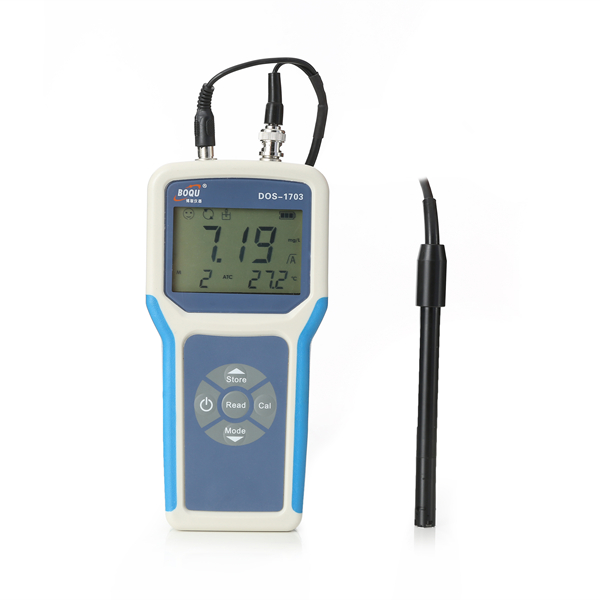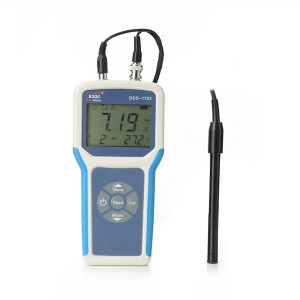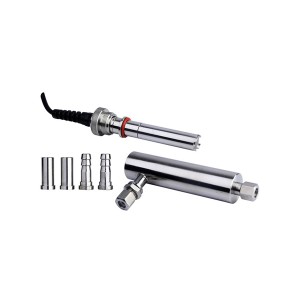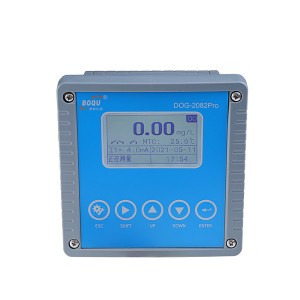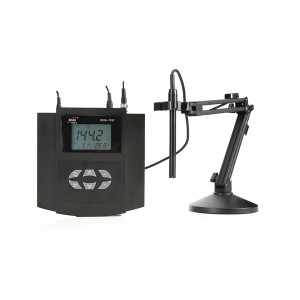DOS-1703 portable dissolved oxygen meter is outstanding for ultra-low power microcontroller measurement and control, low power consumption, high reliability, intelligent measurement, using polarographic measurements, without changing the oxygen membrane. Having reliable, easy (one-hand operation) operation, etc.; the instrument can display dissolved oxygen concentration in two kinds of measurement results indicates, mg / L (ppm) and the oxygen saturation percentage (% ), in addition, measure the temperature of the measured medium simultaneously.
|
Measuring range |
DO |
0.00–20.0mg/L |
|
|
0.0–200% |
|||
|
Temp |
0…60℃ (ATC/MTC) |
||
|
Atmosphere |
300–1100hPa |
||
|
Resolution |
DO |
0.01mg/L,0.1mg/L(ATC) |
|
|
0.1%/1%(ATC) |
|||
|
Temp |
0.1℃ |
||
|
Atmosphere |
1hPa |
||
|
Electronic unit measurement error |
DO |
±0.5 % FS |
|
|
Temp |
±0.2 ℃ |
||
|
Atmosphere |
±5hPa |
||
|
Calibration |
At most 2 point, (water vapor saturated air/zero oxygen solution) |
||
|
Power supply |
DC6V/20mA; 4 x AA/LR6 1.5 V or NiMH 1.2 V and chargable |
||
|
Size/Weight |
230×100×35(mm)/0.4kg |
||
|
Display |
LCD |
||
|
Sensor input connector |
BNC |
||
|
Data storage |
Calibration data;99 groups measurement data |
||
|
Working condition |
Temp |
5…40℃ |
|
|
Relative humidity |
5%…80% (without condensate) |
||
|
Installation grade |
Ⅱ |
||
|
Pollution grade |
2 |
||
|
Altitude |
<=2000m |
||
Dissolved oxygen is a measure of the amount of gaseous oxygen contained in water. Healthy waters that can support life must contain dissolved oxygen (DO).
Dissolved Oxygen enters water by:
direct absorption from the atmosphere.
rapid movement from winds, waves, currents or mechanical aeration.
aquatic plant life photosynthesis as a by-product of the process.
Measuring dissolved oxygen in water and treatment to maintain proper DO levels, are crucial functions in a variety of water treatment applications. While dissolved oxygen is necessary to support life and treatment processes, it can also be detrimental, causing oxidation that damages equipment and compromises product. Dissolved oxygen affects:
Quality: The DO concentration determines the quality of source water. Without enough DO, water turns foul and unhealthy affecting the quality of the environment, drinking water and other products.
Regulatory Compliance: To comply with regulations, waste water often needs to have certain concentrations of DO before it can be discharged into a stream, lake, river or waterway. Healthy waters that can support life must contain dissolved oxygen.
Process Control: DO levels are critical to control biological treatment of waste water, as well as the biofiltration phase of drinking water production. In some industrial applications (e.g. power production) any DO is detrimental for steam generation and must be removed and its concentrations must be tightly controlled.

